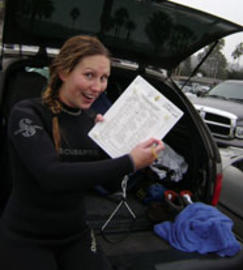REEF is proud to partner with over 130 dive shops, dive clubs, individuals, and other organizations as REEF Field Stations
Join us at Silent World in Key Largo FL for the Great Annual Fish Count. We will be holding a free REEF Fish Identification Course between 9:00am - 11:30am that will be free of charge. This course is open to all of those who will be joining us for the afternoon Fish Survey that will include two dive sites off the coast of Key Largo. Dive Trip charge is $80.00 per person and includes tanks and weights, rental equipment is available for an extra charge of $30.00 per diver.
Fish Survey Dive and BBQ
Saturday, July 9, Diving Starts at 8:00am
Lovers Point Beach, Pacific Grove
Sponsored by the Dive Club of Silicon Valley
Fish Identification for Divers
Tuesday, June 28, 7:00pm
Presented by PADI IDC Staff Instructor Mike Davis
Offered by the Dive Club of Silicon Valley at Diver Dan's, Santa Clara
Fish Identification for Divers
Monday, June 13, 7:00pm
Presented by PADI IDC Staff Instructor Mike Davis
Offered by the Dive Club of Silicon Valley at Diver Dan's, Santa Clara
Fish ID for Divers Seminar at the Monterey Bay Aquarium
Saturday, June 11, 1:00 – 4:00pm
Presented by REEF Divers Alex Matsumoto and Keith Rootsaert
Meet at the Membership Entrance,
Proceed to Ocean View Conference Room.
Marine Invertebrate Identification for Divers
Wednesday, June 1, 7:00pm
Presented by NOAA scientist Dr. Steve Lonhart
Offered by the Dive Club of Silicon Valley at Diver Dan's, Santa Clara
New England Aquarium and REEF 10th Annual Great Annual Fish Count at Stage Fort Park, Gloucester, MA. There will also be a picnic, raffles and touch tank. See www.neadc.org/gafc/ for current information.
Make it a weekend and join us on Sunday July 10th for the REEF Pacific Northwest Invetrebrate class 8 am to 12; with two survey dives to follow starting at 1 pm. Classes to be held at Yellow House Hoodsport Washington. Survey paper and slates will be available for use. Hood Canal, WA
Classes are free but you will need to pay entrance fee to Sund Rock should you choose to participate in the dives.
Attend Reef Fish Identification Class 8 am to 12, then join in for 2 survey dives at Sund Rock Marine preserve. Dives in the afternoon starting 1 pm. Classes to be held at Yellow House Hoodsport Washington. Classes are free of charge but you must register in advance. Survey paper and slates will be available for use.
Make it a weekend and join us on Sunday July 10th for the REEF Pacific Northwest Invetrebrate class 8 am to 12; with two survey dives to follow starting at 1 pm. Also held in Hoodsport Washington.

